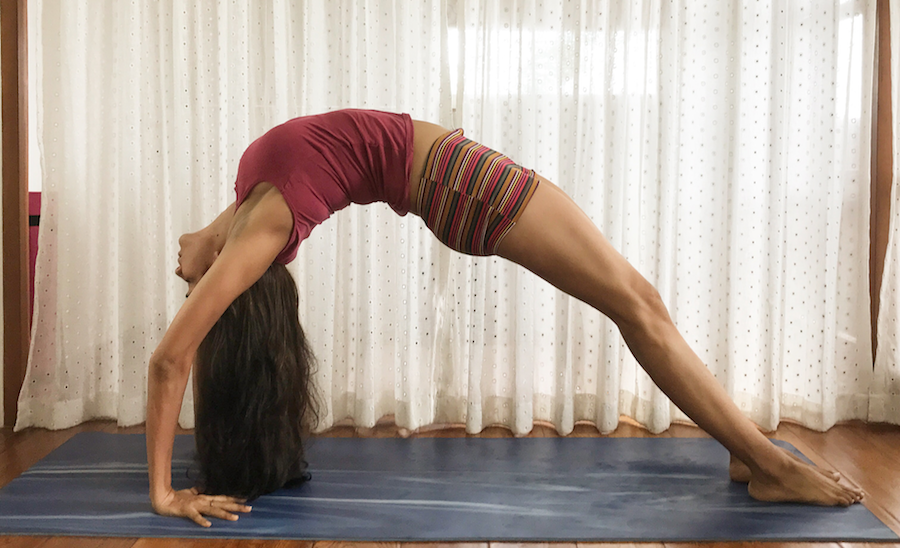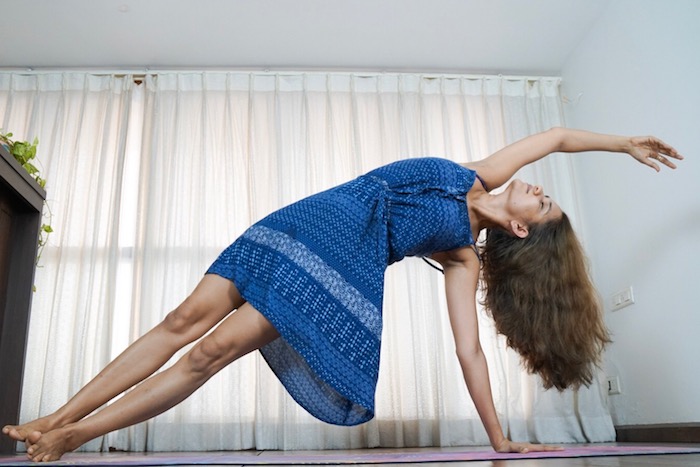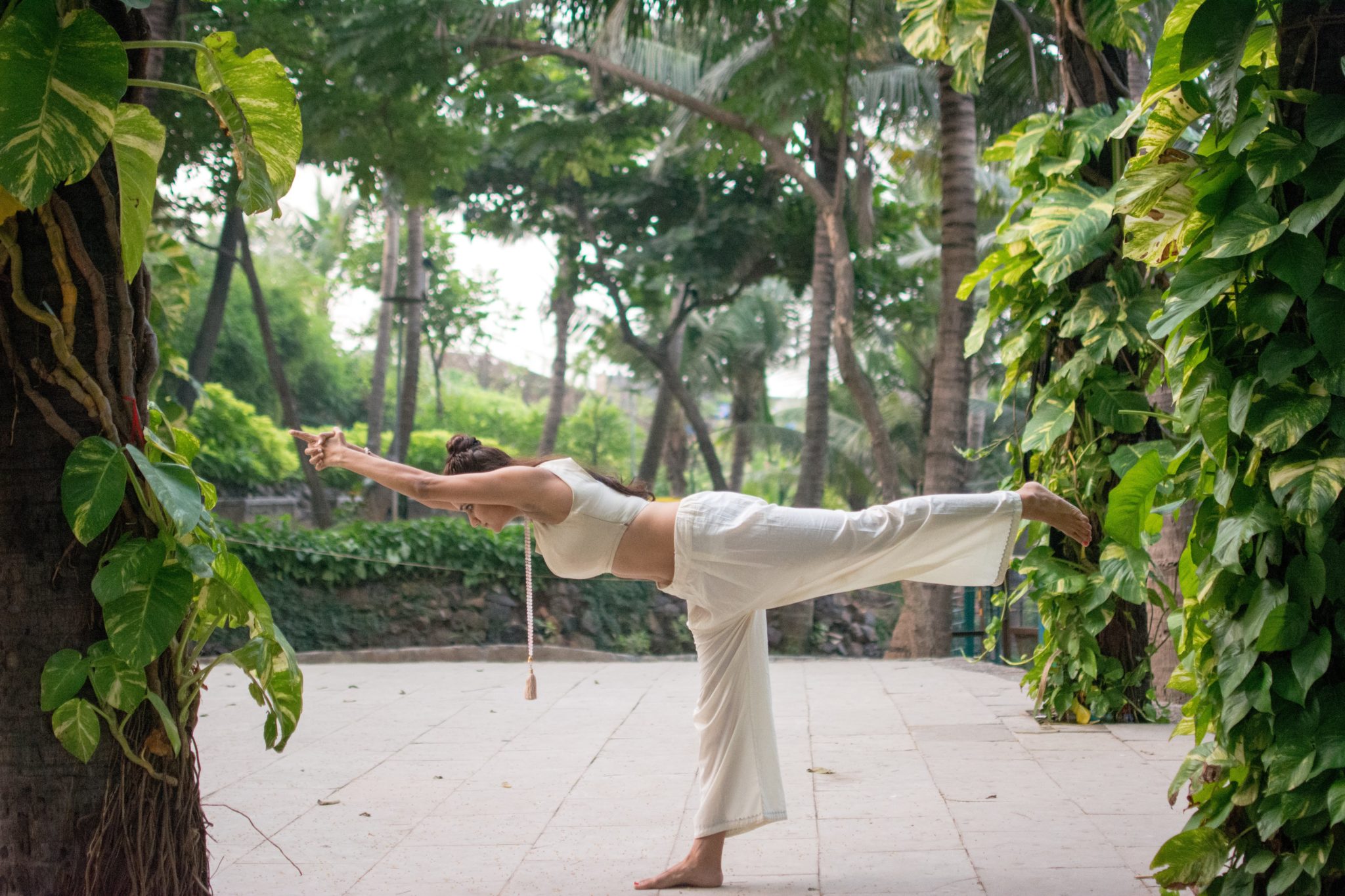As a child, I would often be told that I walk in the line of my nose – straight spine and in one straight line, not deviating an inch. Back in my hometown people would often recognize me simply from my walk and ask if I was my father’s daughter, because of that distinct style. It wasn’t surprising as posture was an integral part of growing up for me and my brothers and mostly it was me and the youngest one who would get pulled up – me for not keeping a straight back and the little brother for keeping his neck out of line (with him it was literally and figuratively both!). Eventually the posture discussion dwindled away and I reckon because we all learnt how to sit, stand and walk the right way – to the approval of my father.
If you just learn to hold your body right, everything that you need to know in this universe you can know ~ Sadhguru
Posture or Asana is how our body chooses to take up space in this world; in fact, in evolutionary terms it is our posture that first made us human. All life originated from one single celled ancestor swimming in the seas and somewhere along the way one life became many different animals and one of those animals became a ‘social’ animal – a human. The single evolutionary characteristic that differentiated this social animal from others was our unique S shaped spine which allowed us to walk upright transforming us from chatushpada (four legs) to dwipada (two legs).
The relative straightening up of the spine, resulted in what were once apes developing the power of discretion and intelligence to eventually evolve into humans. That is, we first developed the ability to stand on two feet before we gained the intelligence and wisdom to develop human values and find success as a species. Perhaps this was the first primeval asana accomplished and perfected by human beings that gave us all the wisdom we have today.
Rare is the birth in a human body, that one does not get again and again.
Once a leaf has fallen from the tree, it cannot be joined back again – Kabir
Many wise men, from Socrates to Hippocrates, have spoken about the importance of Spine and all of modern science continues to implore us to take care of it – we are after all only as young as our spine is healthy. Even the ancients considered the human body sacred, because they understood it as the only available vehicle for spiritual growth that enables us to break out of this material world. We can do that by aligning the body-mind-complex with higher dimensions by recruiting the right posture, that is a straight spine. As per lore, if you don’t make it in this lifetime you have to wait to get a human outfit again and that may be many million years as you traverse the entire food chain being reborn as per your karmas. This body thus becomes significant both as the final milestone in our physical evolution and as the first gateway to the subtle realms.
So how do we use this body form to get the best possible results – the answer simply begins with our posture or asana. Posture is as relevant in daily life as it is in advanced meditative techniques. Whether you want to be a CEO or a Himalayan mystic, you need the right posture to sustain you through the journey.
The significance of Human Spine
Ultimately, posture is nothing but an insight into our spine and our spine is but an insight into our brain. Our spinal column is where the entire network of nerves originates and thus spine is also a part of the nervous system along with the brain. Just as the skull protects the brain, the spinal cord runs protected with-in our spine, piercing each vertebrate, from the brainstem to the root of the coccygeal bone, functioning as the communication highway between the brain and the rest of our body.
In fact, the brain and spinal cord are the first to develop in a human embryo and the rest of our ‘self’ simply develops around it. Clearly following the footsteps of our own evolution when we started as unicellular beings before developing the bearings of a nervous system and evolving around it. In early life forms, its purpose was only to sense and respond and it still does just that today, assimilating the environment (sensory) and preparing a response (motor). We’ve however put it to much broader use than we did when we were mere sponges floating in the sea.
Spiritually, spine is a critical medium for the subtle body as it is the cornerstone of all spiritual development. It is considered a physical embodiment of the mythological mountain called Meru, which is the center of all physical, non-physical and ethereal worlds just as the human spine is the axis of our individual and spiritual existence. It is said that the primordial energy of the universe resides dormant, coiled like a snake at the base of the spine, in every human being as Kundalini. When awakened, it rises up the spine, piercing the chakras, raising our vibrations and carrying its full power all the way to the summit of our brains. And to enable this metaphysical feat, we need to have a straight spine. (Read more about the spiritual spine in this article. Click here)
A bent spine is the enemy of realization. In meditation, always hold your spine straight, so that the life force may flow through it unobstructed ~ Paramhansa Yogananda
How Yoga impacts the spine
Our spine has a unique S Shaped curve that provides most of the support to our body. It allows us to stand with balance, move without falling, lift without crushing and bend or twist without breaking – most importantly it is a stable pedestal for our head. There are three key factors that impact our spine and Yoga plays a crucial role in all.
1. Breath
One of the most competent ways to move the spine is through the breath that creates beautiful extension and flexion movements with the subtle inflow and outflow of air. A German study in 2015 ‘unambiguously’ identified ‘inspiration as the most important driving force for the flow of Cerebrospinal fluid (CSF) in humans’. CSF is an essential medium through which the spine carries nutrients to the brain and waste material out of it. It also provides cushioning and keeps the brain buoyed in suspension reducing its effective weight. Breath works by gently massaging and elongating the spine and is an integral part of spinal health. To learn more about the right way to breathe you can click here to read.
In Yoga, the completely physical aspect of the Spine is reflected in its very spiritual rendition. Yogic philosophy says that our breath controls the nervous system, to the extent that the breath from the right nostril represents the Sympathetic nervous system (that which helps us with our fight or flight function) and the left nostril our Parasympathetic nervous system (rest and digest function). In a study listed by the US National Library of Medicine, a group of scientists tested 48 male subjects who each practiced a specific pranayama techniques for a month. The results were fascinating as they found that breathing ‘selectively’ through either nostril had a distinctly remarkable effect on either relaxing or activating the sympathetic nervous system and that there’s merit in therapeutic implications of altering metabolism by changing the breathing pattern.
All Yoga and Pranayama practices are aimed at balancing both the right and left breath so they can be in harmony with the central or divine energy that runs through the central channel which is physically our spine. All forms of Yoga essentially have one common goal – to strengthen our spine for long hours of sitting for meditation so a continuous energy flow can be maintained without disruption. And meditation is nothing but a magical journey up our spine from the root to the top that we make every day with our breath, albeit without ‘awareness’.
2. Gravity
Gravity along with breath and symmetry has a tremendous influence on the spine. Our spine is made up of individual vertebras which are separated, rather cushioned by spongy spinal discs between them. These facilitate movement, act as shock absorbers and essentially keep bone from grinding against bone. Their job is made more difficult by the impact of gravity on our bodies, which is most visibly felt in our backbone, as it causes our discs to get compressed as they lose moisture throughout the day. The impact is so strong that we actually lose about half an inch of height by evening and regain it after a good night’s rest. If we don’t stand correctly then gravity causes uneven compression in our spinal discs which can lead to early wear and tear.
Furthermore, any imbalance in standing creates an imbalance in our organ systems because gravity pulls us, our blood, organs and even the skin. Constant standing without sufficient relaxation compounded by a poor posture can cause organs to get squashed, prolapse and shift from their normal place in the body. Once an organ is displaced it becomes inefficient, which is why core engagement, posture and spinal strength is so strongly emphasized in yoga. And that is why our gravity-defying act of standing can rapidly degenerate our spine if not done right.
Gravity gives yoga leverage to create an asana or posture with our bodies. We can barely squirm in a zero-gravity environment let alone perform an asana. This powerful force is essential as it allows us to generate energy by just willing to go up against it. However, gravity requires technique without technique we overload our spines and risk injuries rather than benefits.
Yoga gives us that technique because, every movement is coordinated with breath and there’s an element of balance that requires our full focus – in every moment there is complete awareness. That’s why you don’t listen to music while practicing and why every pose has a ‘drishti’ for where we should be concentrating. We cannot live every movement worrying about how we are standing or sitting or moving and Yoga helps by making these principles innate and inherent in our nature. Read more about effects of gravity on spine in this article here.
It is due to gravity that inversions like Viparata Karani / sarvangasana or Shirshasana (headstand) are considered the most powerful and respected poses because they counter the effect of standing all day, they reverse the flow of blood and reverse the direction of gravity on our spinal column. And as a bonus, they also teach us how to look at things differently by turning our world upside down. New perspective?
3. Symmetry
The easiest way to cause physical damage is to mess with our geometry. Even though we’re not symmetrical on the inside but our external view is the balanced version of our internal organization. And nature made it very hard for us to be unsymmetrical. She gave us visual cues which show up long before any permanent structural damage happens inside our body. Whether it is lop sided shoulders, tilted hips, one foot splayed out, we can see it if we’re aware of our bodies. Breaking symmetry causes imbalance, which disrupts our understanding of where we are in space as body compensates for any continuous mistakes in posture by leveraging another joint or organ. When we maintain symmetry, we stay in balance and our center of gravity is then right above our base of support making us efficient in energy consumption. Read more about effects of symmetry on spine in this article here.
We are inherently symmetrical beings and concepts of geometry and mathematics abound even in nature. As per a 2011 study on equilibrium of the body and gravity line – any abnormality in the normal balance of the spine leads to compensation in other parts of the body so as to maintain our center of gravity. This first impacts our pelvic rotation and then the lower limbs and knees. We get into bad posture sub consciously and we need conscious participation to get out of it. This is where Yoga helps.
The ultimate goal of yoga is to bring everything in balance, it is the union of the yin and yang, the sun and moon or simply our right and left sides. That is why each pose has a counter pose – every forward fold has a back bend, every twist a reversal, every upright position an inversion and every supine position a prone pose. There is no movement that is not balanced by its counter movement. We work on the body entirely and completely. We are continuously trying to center ourselves, to balance equally on both sides, to put equal weight on both arms and legs – we are trying to stay in equilibrium. And a physical equilibrium means an emotional equilibrium – that is why after yoga classes one feels so relaxed and calm.
Ultimately, it doesn’t take much to throw our spine off especially if the surrounding musculature is not strong and flexible; it’s just the evolutionary baggage we carry (literally) on our backbones. Thus, we need to align ourselves with the force of gravity, maintain our symmetry and breathe correctly to keep our spine in efficient working condition even in old age. Yoga helps us achieve all of this and all of this is Yoga. Not flexibility, not gymnastics, not a weight loss program, not a tool to heal your diseases – Yoga is Spinal health.
What is a good posture?
And the easiest way to maintain spinal health is through posture. Because we are bi-pedals, the best posture with maximum efficiency happens when our heads are directly above our center of gravity and our knees directly below; when head, neck and shoulders are one line; chin is parallel to the ground; hips, knees and feet are facing forward and weight is evenly distributed over both legs. Those who are familiar with yoga would recognize the position I’ve just described as Tadasana. This is the very beginning of Yoga and the first posture that a Yoga practice starts with, it is the first pose of Surya Namaskara and it is also the first posture that humanity itself started with.
Unfortunately, today most of us suffer from bad posture. An important study by Harvard Professor Amy Cuddy even identifies a strong connection between posture and attitude. Study results found that when in collapsed or closed positions (such as when working on our small mobile phones) we also become less likely to ‘stand up’ for ourselves, that we literally don’t have a strong backbone or shall we say we become ‘spineless’. On the other hand, people who got larger devices like desktops and laptops showed a marked improvement in attitude and body language, sat upright and were more assertive.
In another study by Erik Peper and I-mein Lin, a strong connection was found between posture and energy levels or mental states. It stated that ‘sitting collapsed’ might over time decrease energy and evoke depressive symptoms. In fact, we are more likely to think negative thoughts and recollect bad memories when slouching rather than when standing tall. The study thus concluded that the ‘mind-body relationship is a two-way street; mind to body and body to mind’. Something that Yogis have been reiterating since eons, for the greater good of our race.
In Conclusion…
Today man doesn’t walk or sit; instead he slouches, hunches, flops and sprawls. Whether it is weight loss, energy, injuries or efficiency, it’s all impacted by the prehistoric act of upholding our spine. When we don’t stand correctly, we can’t walk correctly and if we can’t do these we can never sit correctly. We aren’t active and engaged but passive, not even using all parts of our body anymore, which doesn’t bode well for our alignment, structure and organs and also our mind. Almost everyone has suffered a back issue at some point and the most prevalent, and preventable, cause is incorrect posture.
Yoga is all about the spine and spine is all about the Posture (Asana). We have defied gravity for bigger gains and in losing touch with our basics we are paying the price for it. We must not forget that the spinal column is the home of our nervous system. So, our posture influences both our physical and emotional well-being. Simply by sitting and standing up straight we can revolutionize our mind and bodies by becoming more efficient in the way we work as well as smarter and sharper in our thinking. But elementary as it is, posture is no longer a subject of discussion or a matter of importance today. Even though it is more relevant than ever before, with us living in the era of iHunch and iSlouch, our spines governed by our very digital and very inactive lives. It creates urgency to reiterate that we’re human because we stand tall on two feet, on the strength of our spine and no creature on the entire planet can do that.
What becomes of this body is nothing but a reflection of how we’ve lived our lives ~ either engrossed in it or enlightened in it. Our spine is the greatest gift of nature and we have the responsibility of taking care of it with all our awareness. And that’s precisely the simple piece of wisdom that our ancestors left us with as well. After all, both being human or superhuman (enlightened?) requires us to have a straight posture and an upright spine. Simply said, good posture is freedom, in more ways than one. And that is Yoga.








Dear Namita,
I generally read all your articles and truly find them authentic and informative . I find enthusiasm , inspiration and dedication in your writing style. Congratulations on continuing to work with sincerity. Best wishes always!
Thank you so much Meet. I somehow missed this. Really appreciate your words and they mean a lot.